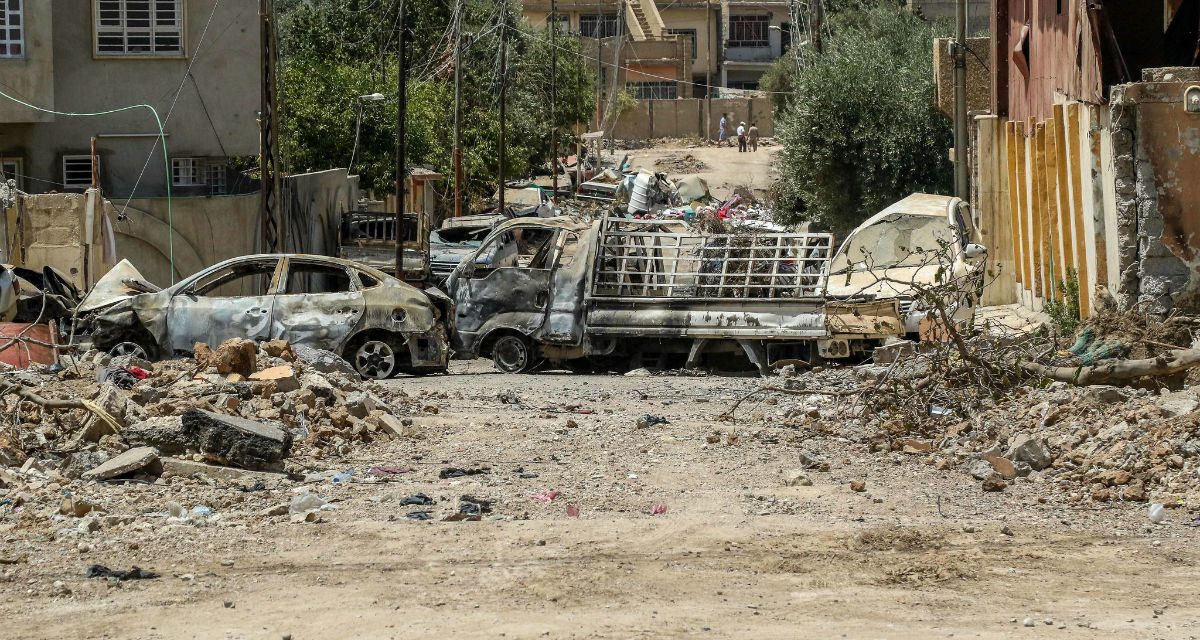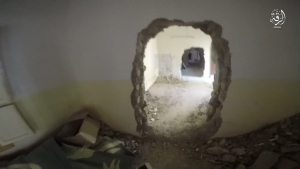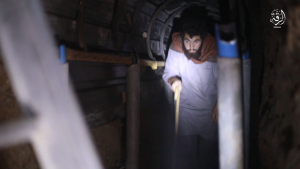The Islamic State group (IS) has spent the last few years fighting a series of defensive battles—many of them in cities—trying to halt a series of territorial losses. In urban battles IS put up stiff resistance despite facing numerically superior and better equipped opponents, who were backed with airpower. In Raqqa the battle was described as taking place in two cities, one above ground and one below, where IS members moved through tunnels to stage attacks where they choose. Anti-IS fighters in Raqqa and Mosul talked about the dangers from snipers, armed drones, IEDs, and suicide vehicle-borne IEDs (SVBIEDs). Often these tactics were used to try to counter advantages of IS’s opponents. Learning lessons from these cases—the most current and relevant examples of urban warfare—is essential. If they fail to do so, militaries will risk learning them the hard way when it is their own forces experiencing new and deadly tactics firsthand on the battlefield.
Part of IS’s ability to grow rapidly and attract thousands of new recruits was its effective use of media for propaganda purposes. But this media—especially the slickly produced videos aimed at highlighting the group’s battlefield victories—also serve to document specific IS tactics, and help us to understand the specific way IS set out to fight in cities.
Walls, Walls, and More Walls
In the run-up to these urban battles IS made significant preparations including stockpiling supplies, producing weapons, and preparing defensive positions. Mosul and Raqqa saw the construction of extensive defensive lines on the edge of the cities involving barricades, trenches, and berms. In Mosul IS razed buildings outside the group’s defensive lines to ensure its fighters had better lines of observation. These defensive lines were meant to make it more difficult for opposing forces to enter the city, but, like individual barricades within the city, the lines were only effective when covered with fire. The defensive lines around Mosul and Raqqa were far too long to be effectively manned by IS, so were ineffective at preventing attackers from entering the city. Barricades inside the city were sometimes more effective but they were still relatively easy to remove using bulldozers, heavy weaponry, or even airstrikes.
In Raqqa, it was the 1,300-year-old city wall that proved to be most effective barricade. This stretches for 2,500 meters along the edge of the old city in the center of the modern Raqqa. With only a limited number of entry points the Syrian Democratic Forces (SDF), a predominantly Kurdish militia assaulting the city, were unable to advance until the US-led coalition used airstrikes to destroy two sections of the wall.
In the part of southern Damascus controlled by IS, barricades saw more use. This was most likely due to the nature of the battle—it was effectively a protracted siege. As well as creating obstacles for attackers, IS used higher barricades to block line of sight. IS defenders also hung sheets of tarpaulin vertically across streets for the same reason. This tactic was not seen in Raqqa or Mosul, though in Raqqa large sheets were hung horizontally from building to building to obscure aerial observation. While these were taken down before the start of the battle IS used smaller sheets of tarpaulin during the battle to hide vehicles and weapon positions.
Harassing the Enemy
After their opponents entered the city proper, breaching ineffective outer defensive lines, much of IS fighters’ urban tactics focused on harassing their opponents, intending to slow down their advance—mainly with IEDs, snipers, and drones. Snipers were highly regarded among the group, featuring prominently in propaganda. IS snipers would pick off fighters, cover barricades with fire, and pin down enemy forces, as well as supporting larger counterattacks. Snipers were known to target weak spots of vehicles, such as the radiator, forcing fighters to wait for repairs or replacement. Both snipers and regular IS fighters would often use “murder holes,” small holes made in walls that allowed them to fire while remaining completely in cover.
IS would use other weapons such as recoilless rifles, mortars, heavy machine guns, and anti-tank guided missiles (ATGMs) to harass enemy forces. The group intended to inflict enemy casualties but reduce the risk to its own fighters by using these longer-ranged weapons, often setting up and firing opportunistically rather than in pre-prepared defensive positions. In Raqqa and Mosul, IS experimented with remote-controlled recoilless rifles and heavy machine guns to further reduce risk. The group modified weapons so fighters could aim and fire them remotely, normally using a videogame controller and a TV screen linked to a camera attached to the weapon.
IS has used IEDs widely as long as the group has existed. In urban settings, IS fighters mainly used them to harass enemy forces and slow their advance. While many IS-deployed IEDs were complex, including large car bombs and some that were motion-activated, the real focus was on quantity, with IEDs being mass produced before and even during battles. In Raqqa, more than 80 percent of attacks on SDF by IS were in the form of hidden IEDs.
Send in the Drones
IS has also long used drones for propaganda purposes and reconnaissance, but during the battle for Mosul they took on a deadlier role. The group modified off-the-shelf commercial drones to enable them to drop small bombs. While not the first group to do this, IS deployed these weapons on a remarkably large scale, with reports from Mosul of up to seventy attacks a day. The tactic soon spread to other IS-held territory, where it was used in other urban battles such as Raqqa.
Propaganda videos released by IS show armed drones being used opportunistically, targeting groups of enemy fighters and vehicles. Like snipers and IEDs, this allowed IS fighters to target their opponents with limited risk to themselves. They were also employed with considerable tactical complexity; one propaganda video showed a drone dropping a bomb onto an ISF position, followed quickly by an SVBIED attack. IS used the drone as a distraction so the ISF would not be able to flee from the incoming SVBIED or attempt to destroy it. SDF fighters in Raqqa said that IS used drones to attack logistic lines and ammunition depots. They also reportedly used drones as area-denial weapons, with two to three drones rotating attacks on a position, allowing bombs to be dropped throughout the day. On occasion, this tactic prevented the SDF from setting up sniper positions on the roofs of tall buildings.
The role of drones outside of dropping bombs must not be overlooked. Their reconnaissance role was invaluable, enabling IS to better plan attacks such as identifying the best route for an SVBIED to take to avoid checkpoints and barricades. They could also enable a “controller” to view real-time footage of an SVBIED attack from a drone, letting the controller talk an IS driver through the attack.
Car Bomb Armada
SVBIEDs are perhaps the best known and most feared of IS weapons. The urban combat of Mosul saw the start of a new evolution of these weapons, the camouflage SVBIED. IS mounted armor onto vehicles to protect against incoming fire. But the armor also made it identifiable as an IS vehicle. Camouflage SVBIEDs masked the armor to make it as indistinguishable from a civilian vehicle as possible. This cost the various forces operating against IS valuable time trying to decide if a vehicle barrelling towards them was filled with explosives or civilians trying to flee conflict.
In defensive urban combat IS employed SVBIEDs as momentum breakers intended to stall attackers’ advances. They were also one way IS staged attacks behind enemy lines. Of the twenty-three SVBIED attacks IS released pictures or videos of in Raqqa, the two that appeared most deadly occurred behind SDF lines. For these attacks IS would either use an SVBIED left behind in an already liberated areas or carry out reconnaissance and plan a route for the SVBIED that avoided checkpoints and barricades until it reached the target.
Finally, IS sometimes deployed multiple SVBIEDs to spearhead major counterattacks. In the city of al-Bab in Syria’s Aleppo province Turkish soldiers and Turkish-backed fighters operating against IS and the SDF successfully captured the Sheikh al-Aqil mountain and al-Bab hospital. However, during a counterattack, with SVBIEDs in the vanguard, a total of sixteen Turkish soldiers were killed and thirty-three wounded (along with an unknown number of Turkish-allied fighters’ casualties). IS destroyed or captured multiple vehicles, including several Leopard 2A4 main battle tanks. Similar counterattacks occurred in Mosul on several occasions. Perhaps most notable was the attempted capture of al-Salam hospital, where a group of around one hundred ISF were cut off and faced a large IS attack that included the use of six car bombs. The ISF suffered heavy casualties and IS succeeded in destroying or damaging twenty vehicles.
Battlefield Maneuver
IS grouped most of its forces during defensive urban battles into small, squad-sized units of six to twelve men. These units would stage attacks and raids on enemy positions, while regularly infiltrating into liberated neighborhoods, enabled by an extensive network of mouse holes and tunnels. Mouse holes are man-sized holes made in the walls connecting two buildings. The tunnels used by IS varied in scale and quality, but some of the most advanced contained supports, lights, and side rooms. This meant they didn’t just function as a way for fighters to move around the battlefield, but also as a location for fighters to stay without risk of attack and for leaders to use as command-and-control centers.
IS attacks behind enemy lines often forced its opponents to re-allocate forces from frontline positions, reducing pressure on other areas, while the use of tunnels also allowed IS fighters to recapture lost areas. SDF members in Raqqa experienced IS fighters emerging from tunnels directly into buildings they were occupying on the front line. It could take weeks to reverse these incremental IS gains. This style of very mobile defensive tactics let IS seize the tactical initiative on many occasions.
In preparation for these attacks, squads of IS fighters used maps to familiarize themselves with the area they would be operating in. Many IS fighters have a “uniform” which identifies them to their comrades in the heat of battle, but when this was not the case, before staging an attack a squad of IS fighters would often put strips of colored cloth on their arms to help identify each other. These small squads of IS fighters appeared to generally have at least one light machine gun and anti-armor weapon among them.
Excluding SVBIEDs, in defensive battles IS primarily relied on infantry, because vehicles were comparatively more vulnerable to the total air superiority of the group’s opponents. However, IS did use some vehicles. Fighters used motorbikes to quickly move around the battlefield, and occasionally used IS-produced, improvised armored personal carriers. IS used “technicals”—pickups equipped with heavy machine guns or autocannons—to attack enemy positions or, largely ineffectively, as anti-aircraft weapons. On a handful of occasions, IS was also seen using truck-mounted artillery pieces. These vehicles required effective deception to prevent them being targeted by airstrikes, so they were hidden in garages or under sheets when not being used.
Human Shields
Civilians in these cities typically sought to flee before battles started, but this wasn’t always possible, especially as IS often took steps to prevent them from leaving. Even in the final stages of the battles for Mosul and Raqqa, tens of thousands of civilians remained. By preventing civilians from leaving IS intended to reduce their opponents’ overall use of airstrikes and artillery. More specifically, IS used civilians as human shields to prevent airstrikes on certain locations. ISF in Mosul described IS fighters operating on the top floors of buildings, while forcing families to stay on the ground level, limiting how much heavy weaponry could be used. Likewise, IS used civilians in Raqqa to secure strategic locations from airstrikes, including by forcing children to stand outside SVBIED factories.
While IS fighters commonly used the tactics described, they did not universally so and tactics varied from city to city. These differences were on occasion borne out of necessity, such as in southern Damascus. Constantly besieged, IS forces there had limited equipment and supplies available to them. This meant that IS rarely used SVBIEDs and armed drones. On other occasions, IS fighters adapted their tactics to best counter the opponents they were facing. Against a force equipped with large numbers of tanks and other vehicles, such as in al-Bab or Mosul, IS often deployed large amounts of ATGMs on the outskirts of the city. Whereas in Raqqa’s outskirts IS didn’t utilise ATGMs on the same scale, as the SDF were a light infantry force with limited numbers of vehicles.
These tactics were also not limited to Iraq and Syria. When IS militants in the Philippines seized the city of Marawi in May 2017, they employed many of the same tactics seen in Raqqa and Mosul, including human shields, mouse holing, snipers, and IEDs.
While not all of the tactics IS employed were successful—outer defensive lines failed to stop attackers from entering cities, for example—they were broadly effective. The use of snipers, IEDs and armed drones to harass the group’s opponents, along with SVBIEDs employed as momentum breakers, slowed the pace of attackers’ advances. The mobile defensive tactics of small infantry squads often allowed IS to seize back the tactical initiative. When necessary, IS could also mass forces for large counterattacks. The use of both SVBIEDs and infantry using tunnels to stage attacks behind enemy lines was also very effective.
Eventual victories came at a cost for the attacker; some units of the ISF’s elite counterterrorism force reportedly suffered up to 50 percent casualties. And even when dislodged from cities like in Damascus and Raqqa, IS was able to secure the evacuation of its remaining fighters.
So what can we learn from IS’s urban battles? Most of the tactics IS employed were intended to counter the advantages enjoyed by attackers that often had better equipment, greater numbers, and total air superiority. For a force like those of Western militaries, who are used to fighting with these advantages, it will likely be these tactics deployed against them when they next fight in an urban environment. IS didn’t invent these specific tactics, but they arguably perfected them. In so doing, they developed a guidebook for groups fighting against superior adversaries, which means the likelihood they will be employed in urban environments in the future is high, irrespective of whether IS is involved. It is essential to learn about these tactics now in order to inform effective strategies and tactics to counter them, rather than waiting until soldiers find themselves on an urban battlefield, with enemy fighters emerging from tunnels directly into the buildings they occupy, drones attacking from the skies, and waves of SVBIEDs hurtling toward them.
Robert Postings is a freelance writer whose research focus is the Islamic State. He has published work with the International Review and the Counter Extremism Project. You can reach him on Twitter: @RobertPostings.
The views expressed in this article are those of the author and do not reflect the official policy or position of the Department of the Army, Department of Defense, or the US government.
Image credit: Staff Sgt. Jason Hull, US Army






While they used these tactics admirably (loathe as I am to call anything daesh does as admirable), these tactics were “perfected” long before the above player even existed; it is basic Infantry and Engineer tactics, which have proven effective for decades. Nothing novel was achieved, beyond the already-forgotten lesson that technology, on its own, is not a replacement for expertise.
Thank You